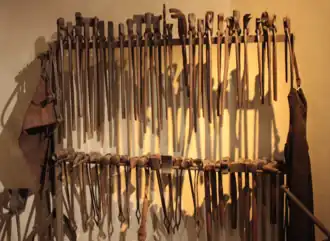



Pincers are a hand tool used in many situations where a mechanical advantage is required to pinch, cut or pull an object. Pincers are first-class levers, but differ from pliers in that the concentration of force is either to a point, or to an edge perpendicular to the length of the tool. This allows pincers to be brought close to a surface, which is often required when working with nails.
Pincers are primarily used for removing objects (typically nails) out of a material that they have been previously applied to. Carpenter's pincers are particularly suited to these tasks.
Sharpened pincers are also used to cut away natural calluses, also called chestnuts, from a horses body.[1]
Further use of pincers is the trimming of the edges of horses hoofs.[2]
If the pincers have perpendicular cutting edges, the pincers are often called end-nippers or end-cutters.
Pincers, often red-hot, have also been used as an instrument of torture[3] since ancient Roman times or earlier.
Pliers are a similar tool with a different type of head used for squeezing, rather than cutting and pulling.